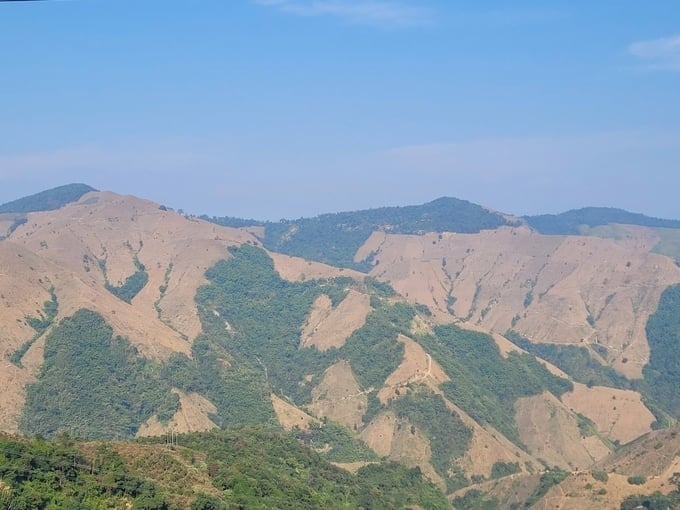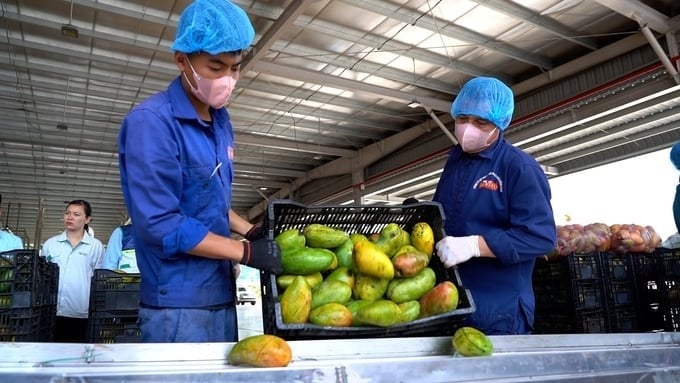November 20, 2025 | 00:21 GMT +7
November 20, 2025 | 00:21 GMT +7
Hotline: 0913.378.918
November 20, 2025 | 00:21 GMT +7
Hotline: 0913.378.918
Climate change has had profound impacts on socioeconomic systems, especially in agriculture, and fruit trees are particularly vulnerable. Major agricultural markets such as the European Union and the G7 are now enforcing stricter technical standards through mechanisms like the Carbon Border Adjustment Mechanism (CBAM). These policies necessitate that imported products adhere to greenhouse gas reduction standards or be subject to carbon levies through credit systems.
These regulations illustrate that market barriers have expanded beyond food safety. Carbon traceability, transparent production data, and green certification are becoming indispensable for market access, serving as a "visa" for Vietnamese products to compete on a global scale. For Son La, a province with substantial natural resources, this is especially important: it has a temperate climate that is conducive to fruit production, vast forested land, and undulating terrain that is ideal for perennial crops.

Increasing green coverage thanks to fruit trees. Photo: Duc Binh.
Son La has a substantial carbon sequestration potential, with an estimated 653,000 hectares of forestry territory and 408,000 hectares of farmland. Nevertheless, Dr. Nguyen recognizes significant obstacles. VietGAP traceability standards are met by approximately 15% of fruit cultivation areas, according to a 2024 survey conducted by the provincial Department of Agriculture and Environment. This figure is significantly lower than international standards. In the interim, the province's produce is primarily consumed fresh, accounting for approximately 75% of its output. This exposes growers to price instability and waste. It is not uncommon to experience losses of 10–15% per season.
There have been no formal initiatives initiated to quantify or monetize the carbon absorption, despite the potential to sequester an estimated 5.6 million tons of CO₂ annually.
ECM suggests a five-part strategy for Son La to promote sustainable development alongside with fruit cultivation.
Initially, construct a carbon economy map in accordance with the three-tier framework of the IPCC. The calculation of biomass-based carbon credits should be founded on Tier 2 data, which has been internationally verified. Real-time monitoring of greenhouse gas emissions in fruit-growing zones is a requirement of Tier 3, the most stringent level. This system not only monitors actual emissions but also offers comprehensive data to confirm cultivation practices, improve traceability, and specify the origin of products.
Subsequently, establish partnerships with international partners to implement quality standards that are suitable for export. For instance, Japan has upgraded VietGAP to levels that are equivalent to JGAP or JAS. This entails four critical procedures:
Systematize Son La’s major agricultural products:
Third, make a significant investment in deep-processing technologies that are integrated with circular economy principles and utilize sophisticated cold-chain systems. LNG (liquefied natural gas) technology has the potential to substantially reduce costs while maintaining the quality of the product for a period of 6 months to 5 years. These preserved products could be utilized as inputs for the pharmaceutical and food industries.

Fruit deep processing system at DOVECO Son La. Photo: Tung Dinh.
Fourth, Son La should systematically and actively penetrate the carbon credit market after the carbon economy map is established. In order to provide training to specialized staff, business executives, cooperatives, and large landowners in carbon accounting and credit registration, it is essential to collaborate with universities and research institutes.
Additionally, a prototype project that utilizes "cooperative–carbon credit" models is suggested. In this model, cooperatives would organize farmers to implement green farming techniques, including the utilization of organic or microbial fertilizers to increase soil organic carbon by 10% over a three-year period, the intercropping of legumes to fix nitrogen (which reduces chemical fertilizer use by 20%), and the adoption of drip irrigation (which saves 40% on water usage).
Fifth, Son La should fully capitalize on global e-commerce to establish a connection between its fruits and main domestic cities and global markets. This encompasses the enforcement of product quality standards during production, traceability, and preservation, in addition to the establishment of partnerships with major retailers like BigC and WinMart through B2B channels. By pursuing these five pillars, Son La can realize its maximum potential as a green agricultural hub, where fruit trees not only provide sustenance but also fuel the province's green economy.
Translated by Linh Linh

(VAN) On November 18, Deputy Prime Minister Tran Hong Ha chaired the 22nd session of the National Steering Committee on Anti-IUU Fishing.

(VAN) Prime Minister Pham Minh Chinh has issued an official dispatch directing focused response efforts and the swift remediation of damage caused by recent floods in the Central region.

(VAN) Deputy Minister Nguyen Thi Phuong Hoa calls for prioritizing the livelihoods of coastal residents, particularly those impacted by marine economic development projects.

(VAN) People can now submit their land-use right certificates ('red books') via the VNeID application. This marks an essential step toward fully paperless public services in land administration in the near future.

(VAN) Fishermen and authorities in Khanh Hoa province are demonstrating strong resolve in the fight against IUU fishing, aiming to develop a sustainable fisheries sector and remove the European Commission's (EC) ‘yellow card.’

(VAN) Viet Nam has declared that it will develop and implement strong greenhouse gas reduction measures to achieve Net Zero emissions by 2050 and it is following through on that commitment.

(VAN) A comprehensive legal framework, tailored to domestic conditions, serves as the foundation guiding economic sectors toward low-emission development.